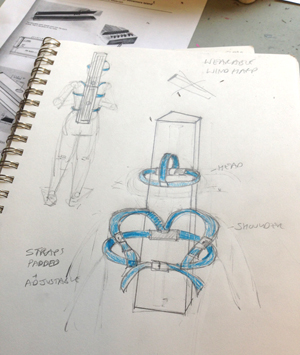On Site | Overtones
Overtones on Governors Island
LMCC's Process Space Residency on Governors Island
Open Studios:
- May 28 & 29 from 12:00 - 5:00pm
- June 25 from 1:00 - 4:00pm
* Related project, Treetones, is a temporary site-specific installation on Governors Island. Hand-sewn fabric flags, made from tree rubbings, are tied to 12 different species of trees on the Island. Through a self-directed walking tour, visitors will be guided by a map to help locate and identify the trees. They can also collect bark rubbings provided at each stop on the tour. Highlighted species include American Elm, Red Oak, Norway Maple, Horse Chestnut and London Plane.
1. Overview
Overtones is a public audio installation that aims to create aural connections to natural environments through the harmonic tones generated by wind harps discreetly installed in trees and abandoned buildings. Through a series of self-guided walking tours, visitors will hear the sounds produced by the wind, an ethereal and unpredictable embodiment of nature. I would like to explore how and why we respond to specific types of sounds, particularly harmonics created by natural forces.
2. Project Design and Research
Keep your lips or finger-tips
For flute or spinet’s dancing chips;
I await a tenderer touch I ask more or not so much:
Give me to me the atmosphere.From “Maiden Song of the Aeolian Harp” Emerson writes from the point of view of the Aeolian Harp.
The Aeolian Harp is a stringed instrument that is played by the wind and produces only harmonic sounds. A traditional version of this wind harp is constructed from a rectangular box with several strings of equal length and of varying thickness tuned to the same fundamental note. When the wind plays the strings, through a vortex shedding effect, it does not play the fundamental note, but rather a series of overtones. Writers such as Wordsworth, Emerson, Coleridge, Poe, and Thoreau have documented a fascination with these sounds. All have written of the harp’s inspiration and/or ability to connect humanity with the beauty and poetry of nature.
Pythagoras is said to have developed the study of harmonics, a numerical science based on ratios used to tune instruments. He and his followers believed that these musical relations had a wider application in the universe. They alleged that the planets circled the heavens in similar mathematical proportions and the ratios also had a mystical connection to the human mind and god.
Through this project, I am exploring why the harmonics created by wind harps and other Aeol instruments have provided such inspiration for poets and scientists; and how to better understand the physics and mathematics behind the phenomenon in order to re-engineer the traditional Aeolian harp for use in public site-specific installations.
3. Construction and Siting
Part of the conceptual aim for this work is to obscure the physical sculpture/instruments and allow the subtle, disembodied harmonics to be the primary focus. One of the challenges of the wind harp is the unpredictability of the player (the wind). Variable wind conditions can make it difficult to create an installation in public locations unless the harp is very large and sited in a consistently windy location. With this in mind I am exploring ways of building the instruments in order to amplify the wind and acoustics, while concealing the instruments themselves.
I am drawn to locations where nature has begun to overtake structures or areas once occupied by humans. One of the traditional installations of a wind harp is to simply place it in a tree or in the open window of a home. During a five-month studio residency hosted by the Lower Manhattan Cultural Council on Governors Island consulted with instrument makers, physicists and musicians to re-think the Aeolian harp, or wind harp, and create a sound installation. Governors Island, while in the process of becoming redeveloped, has many abandoned or underused buildings, beautiful old trees, and is consistently windy, due to its proximity to the water. This made a good site for research.
I constructed a variety of traditional wind harps and also experimented with turning trees into harps by suspending modified wind harps within the branches to achieve the similar effect that Thoreau has described as his telegraph harp.
As I went under the new telegraph wire, I heard it vibrating like a harp high overhead. It was as the sound of a far-off glorious life, a supernal life, which came down to us, and vibrated the lattice-work of this life of ours.
From the journal of Henry David Thoreau, September 3, 1851
--
References:
- The Aeolian Harp Reconsidered: Music of Unfulfilled Longing in Tjutchev, Mörike, Thoreau, and Others, Martin Bidney, Comparative Literature Studies, Vol. 22, No. 3 (Fall, 1985), pp. 329-343, Published by: Penn State University Press
- A Re-Valuation of the Ancient Science of Harmonics, Psychology of Music, 31 no4: 391-403
Sketches / Images:
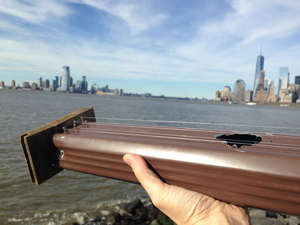 Wind Harp (Gutter) Test on Governors Island
Wind Harp (Gutter) Test on Governors Island
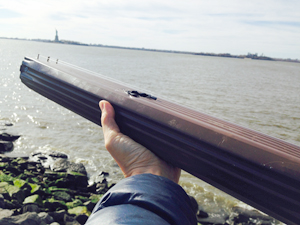 Wind Harp (Gutter) Test on Governors Island
Wind Harp (Gutter) Test on Governors Island
 Wind Harp in Tree on Governors Island
Wind Harp in Tree on Governors Island
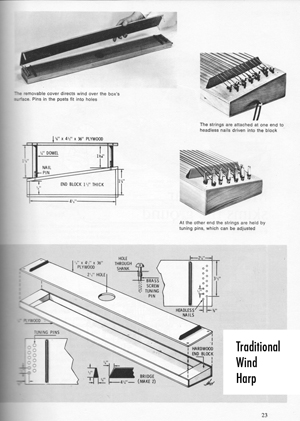 Traditional Wind Harp Instructions
Traditional Wind Harp Instructions
Audio Examples
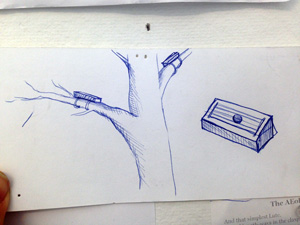 Sketch
Sketch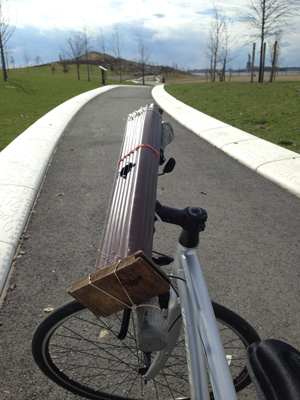 Bike Harp Test
Bike Harp Test